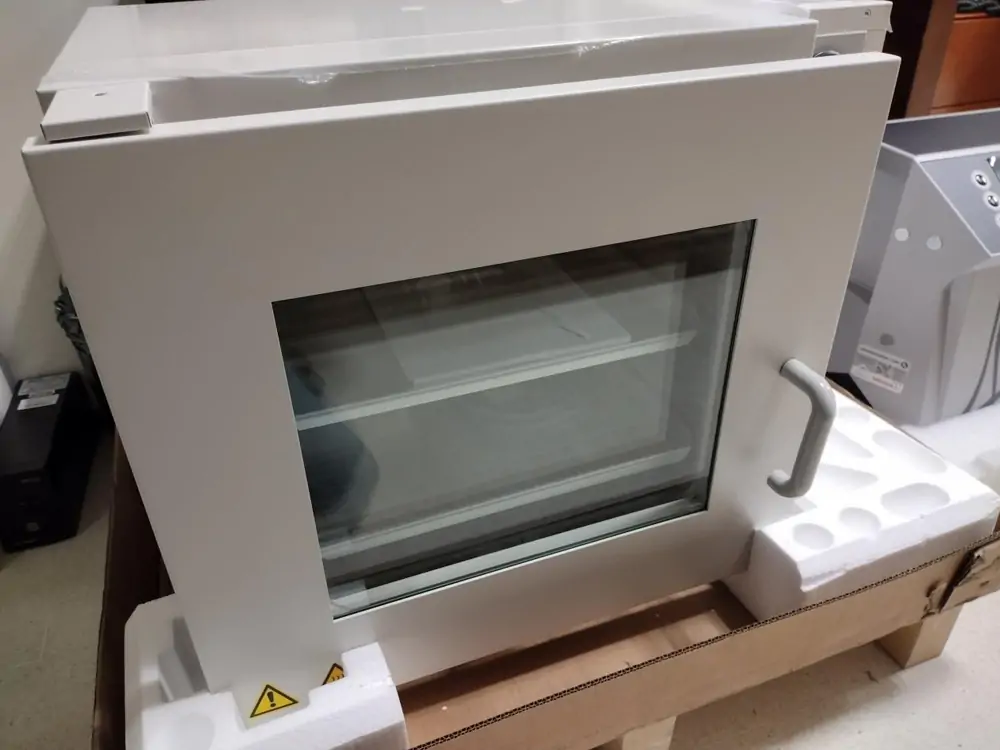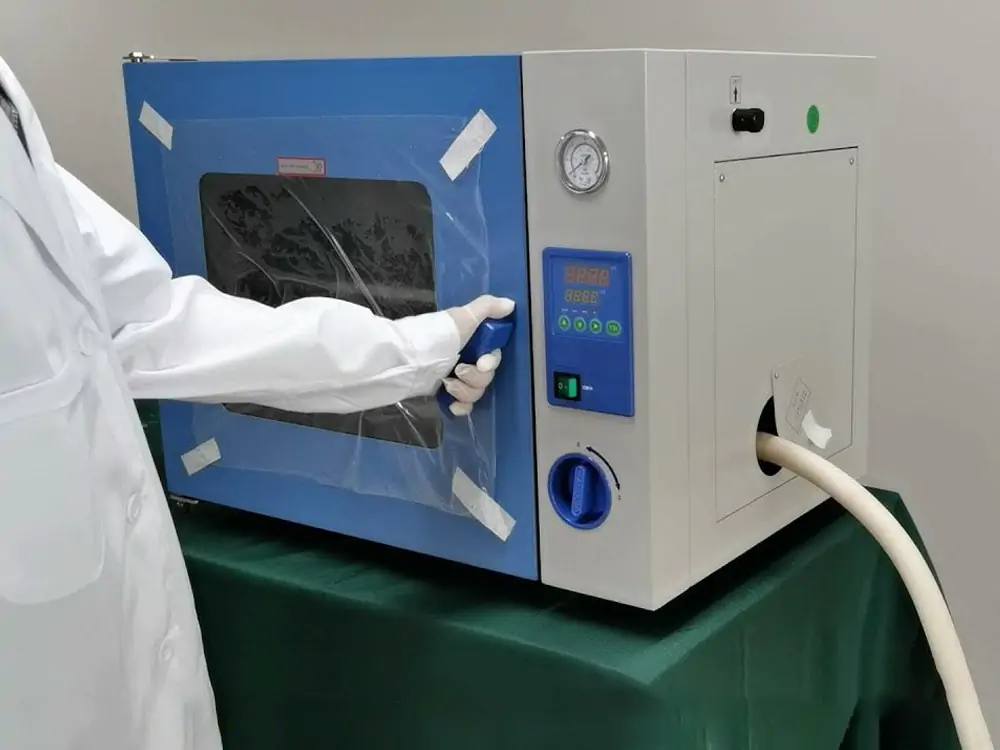Vacuum ovens are an indispensable tool in today’s scientific laboratories and industries. Researchers can precisely control temperatures and process samples under reduced pressure. From drug drying in the pharmaceutical industry to component handling in electronics manufacturing. Vacuum ovens all play a vital role. This results in more precise and controlled sample processing.
Many types of vacuum ovens on the market have various performance parameters. In this complete guide to vacuum ovens, we’ll thoroughly explore all aspects. From basics to advanced features. This article provides you with an opportunity to learn more about this device.
What is A Vacuum Oven
A vacuum oven is a laboratory device designed to heat and dry samples in a vacuum environment. This device is capable of controlling temperature and operating under vacuum. It therefore plays a crucial role in scientific, medical, electronic, and industrial applications. The main features of vacuum ovens include:
- Vacuum Environment: A vacuum oven draws air through a pump, creating a low-pressure environment. It helps lower the boiling point in the sample. It allows for fast and even drying at relatively low temperatures.
- Temperature Control: The vacuum oven has a precise temperature control system. It ensures that the sample is heated within a specific temperature range. It is essential for temperature-sensitive experiments and processes.
- Uniform Heating: A consistent heating system is adopted inside the device. It ensures the sample is exposed to the same temperature effects throughout the oven. It can avoid the influence of temperature gradient on experimental results.
- Sample Safety: The vacuum environment helps reduce oxidation and contamination of the sample surface. Therefore, it is very suitable for processing oxygen-sensitive samples.
- Widely Used: Vacuum ovens are widely used in medicine, materials science, electronics, food industry, and other fields. Typical uses include drying, baking, heat treatment, removal of volatile substances, etc.
- Flexibility: The vacuum oven can meet the needs of different experiments and processes by adjusting the vacuum degree and temperature. Therefore, it has greater flexibility.

Vacuum Drying Oven Uses
A vacuum drying oven is a device that dries samples under vacuum conditions. Such devices are essential in various scientific, research, and industrial applications. Its main uses include but are not limited to the following aspects.
Handling of Gas Sensitive Samples
The vacuum drying oven provides an oxygen-free environment for samples that are susceptible to oxidation or deterioration due to the influence of oxygen. It helps protect and handle these gas-sensitive samples. Such as certain metals, chemical reagents, etc.
Biology And Medical Experiments
In biology and medicine, vacuum drying ovens are often used for processing biological samples. Such as cells and tissues. Low-temperature drying under vacuum conditions can effectively maintain the integrity and activity of biological samples.
Drug Development And Production
In the pharmaceutical industry, vacuum drying ovens are used to dry and prepare pharmaceuticals. It can help remove water from medications. It improves the stability and shelf life of the drug.
Food Industry
In food production, a vacuum drying oven removes moisture from food. It extends the shelf life of food. Vacuum drying ovens have broad applications in making dried fruits, meat products, and other foods.
Materials Research
In materials science and engineering, vacuum drying ovens are used to process and study materials. It can ensure the material has the desired properties under specific temperature and vacuum conditions.
Electronic Component Manufacturing
In the electronics industry, vacuum drying ovens are used to remove moisture from electronic components. It ensures component performance and reliability.
Chemical Synthesis
During chemical synthesis, a vacuum drying oven can be used to remove solvent or moisture from reaction products. It drives chemical reactions to higher purity.
Laboratory Research
In laboratory research, vacuum drying ovens are widely used to process various samples. These include solvent removal, materials research, experimental preparation, etc.

Advantages of Vacuum Ovens
Vacuum ovens offer many advantages in laboratory and industrial applications. These advantages make it an ideal tool for working with specific samples and experiments. Here are some of the main benefits of a vacuum drying oven.
Anaerobic Environment
Vacuum ovens create an oxygen-free or low-oxygen environment by removing oxygen from the atmosphere. It is essential when working with oxygen-sensitive samples. It prevents oxidation and deterioration.
Low Temperature Drying
Under vacuum conditions, samples can be dried at lower temperatures. It helps prevent the thermal sensitivity of specific temperature-sensitive samples. It ensures sample integrity and activity.
Dry Evenly
The interior of the vacuum oven is designed to heat evenly. It ensures the sample is exposed to the same temperature effects throughout the process. It helps avoid the effects of temperature gradients on experimental results.
Quick Drying
The low-pressure environment in a vacuum oven allows moisture in the sample to evaporate more quickly. It makes vacuum ovens more efficient than traditional ovens.
Remove Volatile Substances
Vacuum ovens can be used to remove volatile substances such as solvents and moisture from samples. It is helpful for experiments that need purification or removal of flammable substances.
Avoid Sample Surface Oxidation
The oxygen-free environment in a vacuum oven helps prevent the oxidation of some sample surfaces. It preserves the original properties of the sample.
Sample Integrity
Due to the low temperature and uniform heating properties, vacuum ovens help maintain the physical and chemical integrity of the sample.
Precise Temperature Control
Vacuum ovens are often equipped with advanced temperature control systems. It provides exact temperature control. It ensures the accuracy of the experiment or treatment.

Vacuum Oven Drying Method
Vacuum oven drying is a method of drying samples under vacuum conditions. This method is used to process samples sensitive to oxygen, temperature, or volatile substances. The following are the basic steps and general operating guidelines for the vacuum oven drying method.
Prepare Samples
Place samples to be processed in appropriate containers or vessels. Ensure the sample is evenly distributed for consistent results throughout the drying process.
Set Up The Vacuum Oven
Open the vacuum oven and make sure the inside is clean. Adjust the required temperature and vacuum parameters. Different samples may need different temperature and vacuum conditions.
Load Sample
Load the prepared sample into the vacuum oven. Samples can be placed directly on oven trays or in appropriate containers. It depends on the nature of the sample and the experimental requirements.
Vacuum Extraction
Start the vacuum pump and extract air from the oven to create a vacuum environment. Ensure that the vacuum degree change meets the experimental requirements.
Heating Up
Start heating the vacuum oven, and the internal temperature will gradually increase. Different temperature rising and falling speeds and holding times can be used according to the experimental needs.
Observe Sample Status
During the drying process, the progress of drying can be monitored by observing the condition of the sample. The moisture in the sample will gradually evaporate under vacuum conditions, thereby achieving a drying effect.
Stop Heating And Vacuum
Stop heating when the sample reaches the desired dryness and turn off the vacuum pump. The processed sample can be removed after waiting for the vacuum oven to cool down.
Analyze And Record
Perform necessary analyses on processed samples. Record temperature, time, and other relevant parameters. These data are important for the verification of experimental results and the optimization of future experiments.
It should be noted that the specific steps of the vacuum oven drying method vary depending on the sample’s nature, the experiment’s purpose, and the equipment’s model. Before conducting experiments, refer to the operation manual and adjust the parameters according to experimental requirements.

Vacuum Oven vs. Freeze Drying
Vacuum ovens and freeze drying are both methods used for drying and preserving various materials. But they operate on different principles and serve different purposes. Here’s a comparison between vacuum ovens and freeze drying.
Vacuum Oven
Operating Principle
Heat-Driven Evaporation: In a vacuum oven, drying is achieved by applying heat under reduced pressure. The lower pressure lowers the boiling point of water, facilitating faster evaporation.
Process Temperature
Moderate Temperatures: Vacuum ovens operate at average temperatures. They are suitable for materials that can be affected by higher temperatures.
Speed of Drying
Faster Drying: The combination of heat and reduced pressure allows faster drying than conventional ovens.
Applications
General Drying: Vacuum ovens are commonly used for drying heat-sensitive materials, removing solvents, and available sample drying in research laboratories and industrial settings.
Freeze Drying (Lyophilization)
Operating Principle
Sublimation of Ice: Freeze drying involves freezing and subjecting the material to a vacuum. Under reduced pressure, the frozen water in the material undergoes sublimation. It directly changes from a solid to a gas. Then, leave behind a dried product.
Process Temperature
Low Temperatures: Freeze drying occurs at much lower temperatures than in vacuum ovens. This low-temperature process helps preserve the structure and characteristics of heat-sensitive materials.
Speed of Drying
Slower Drying: Freeze drying is generally a slower process due to the sublimation of frozen water.
Applications
Preservation of Biological And Sensitive Materials: Freeze drying is commonly used for preserving biological samples, pharmaceuticals, and sensitive materials. It is essential to maintain the structure and properties of the material. It is often used in the food industry to preserve fruits, coffee, and other perishable items.
|
|
Vacuum Oven
|
Freeze Drying
|
|
Temperature Sensitivity
|
Moderate temperatures
|
Temperature-sensitive
|
|
Speed
|
Faster
|
Slower
|
|
Preservation of Structure
|
Change
|
Not change
|
|
Applications
|
general drying and solvent removal
|
biological samples, pharmaceuticals, and delicate materials
|
How to Operate A Vacuum Oven
Step 1: Set Parameters
The user sets the required temperature and vacuum parameters through the operation panel.
Step 2: Start The Vacuum Pump
The user activates the vacuum pump, which extracts air from the oven and reduces the pressure.
Step 3: Heating Operation
The heating element begins to provide heat. The temperature in the oven rises to the set value.
Step 4: Sample Processing
Samples are processed in a vacuum and heated environment. Under low-pressure conditions, the water in the liquid part evaporates at a lower temperature.
Step 5: Control And Monitor
The temperature control system monitors the temperature inside the oven in real-time. Adjustments are made via a feedback mechanism to ensure a constant temperature.
Step 6: Stop The Operation
After processing, the user stops heating and turns off the vacuum pump. The pressure in the oven gradually returns to normal.
Step 7: Remove The Sample
When the oven has cooled, the user can remove the processed sample.
Conclusion
The wide range of applications of vacuum ovens makes them an indispensable tool in laboratory and industrial environments. It provides reliable sample-handling solutions for a variety of experiments and processes. Its oxygen-free environment, precise temperature control, and uniform heating characteristics make it excellent for processing various samples.
This guide delves into every aspect of a vacuum drying oven. From basics to advanced features. It provides you with a comprehensive understanding of this critical laboratory equipment. This complete guide will help you make informed decisions about vacuum ovens.
Hopefully, this complete guide will help you better understand how vacuum ovens work, their benefits, and their applications. Please ask us if you have further questions about any issue or need more information. Thank you for reading this guide.